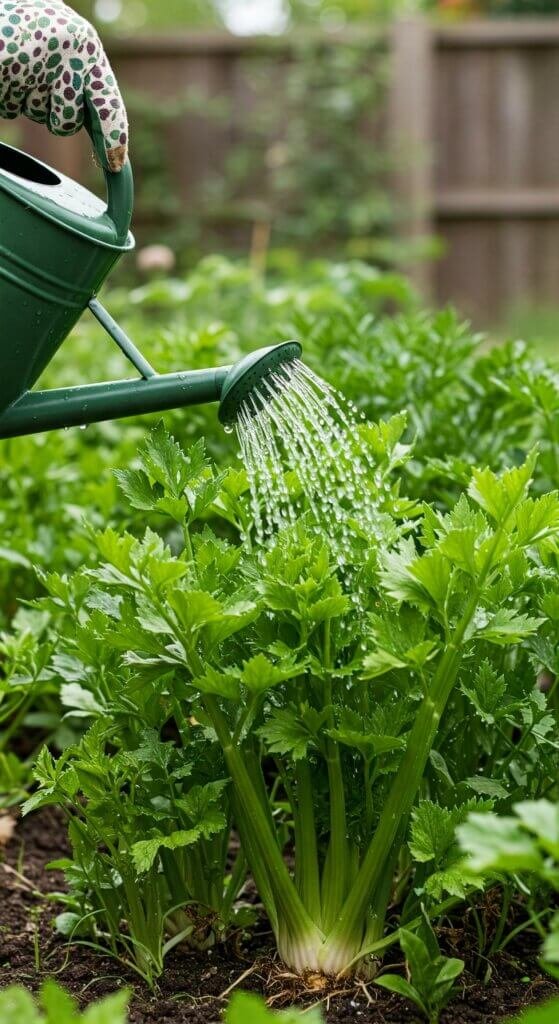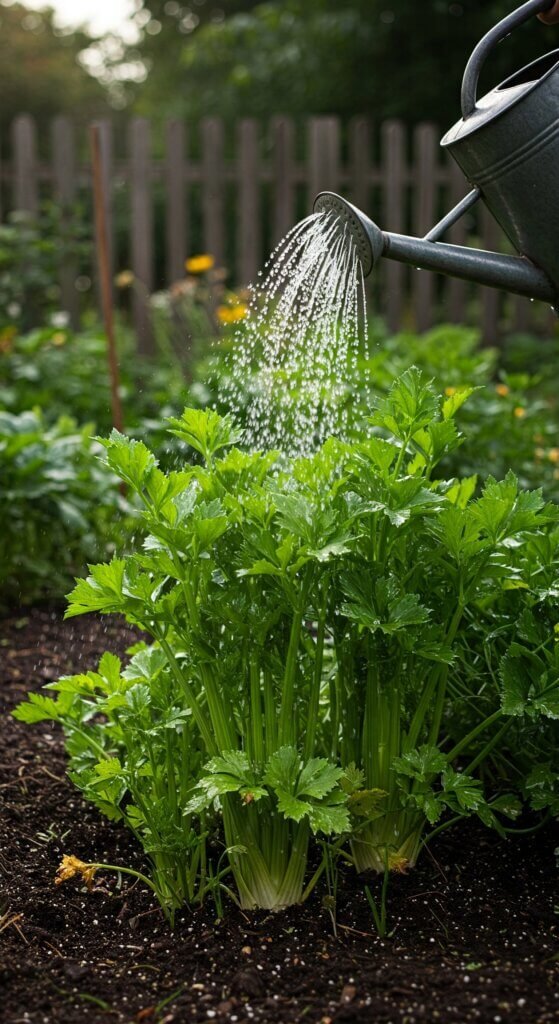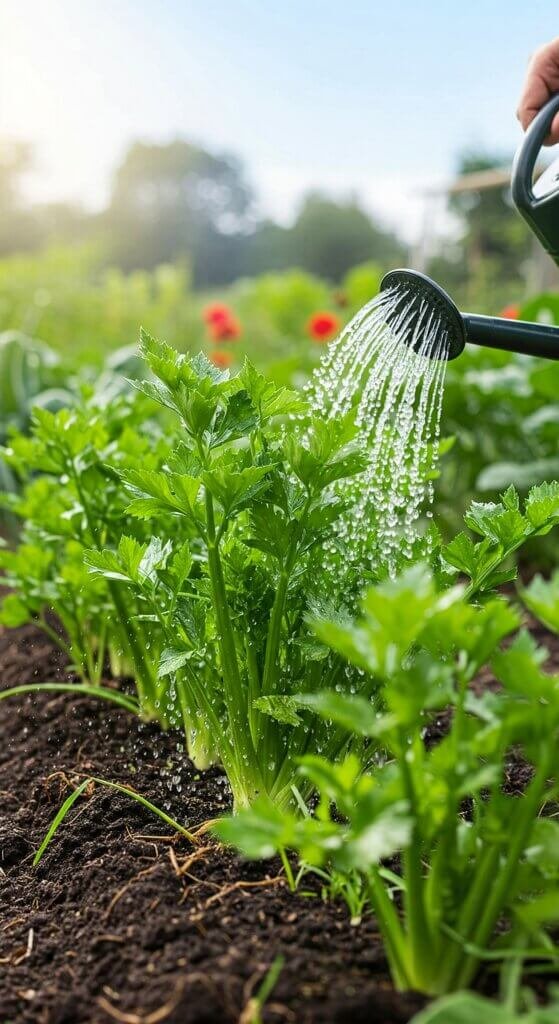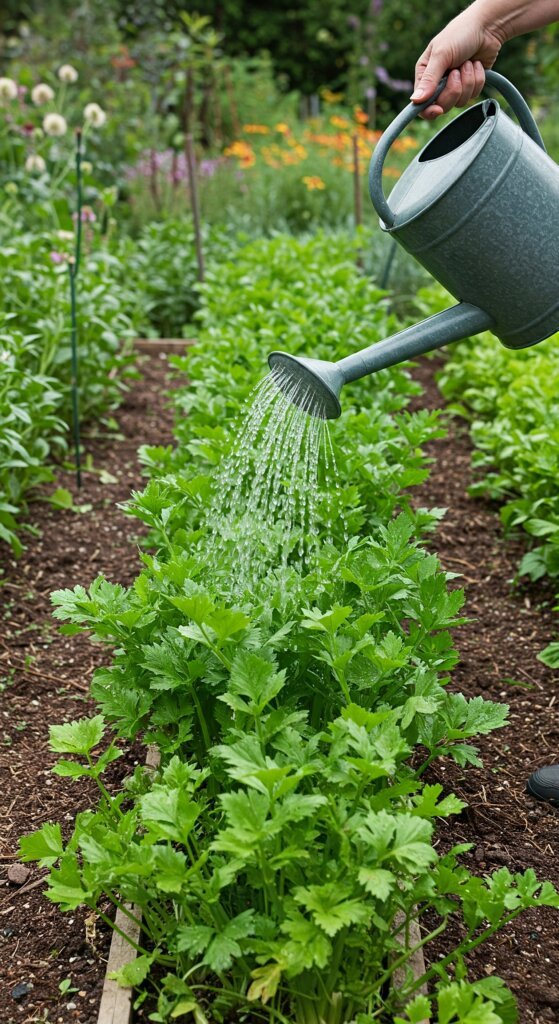
Celery’s not just a sidekick to ranch dip—it’s a diva in the garden, especially in summer.
This plant needs water. A lot of it. Miss a day? Prepare for floppy, bitter stalks.
If you’re growing celery in your backyard, your raised bed, or your “someday I’ll have a farm” patio, watering it right is the secret to juicy, sweet stalks (aka the kind you actually want to eat).
In this guide, we’ll break down a simple summer watering plan, what kind of soil keeps celery happy, and how to tell when your plant’s too thirsty—or drowning.
Basically, it’s the celery survival manual.
Why Celery Is So Sensitive to Water
Celery is not your average veggie.
It’s a cool-season drama queen with shallow roots and a serious need for hydration.
Think of it like that friend who carries a reusable water bottle everywhere and still complains about being dehydrated.
Unlike tough crops that can handle a little dry spell, celery needs a steady stream of water to stay:
- Crisp and snappy (nobody wants limp celery, let’s be honest)
- Bright green like it’s auditioning for a role in Shrek
- Able to actually absorb nutrients without throwing a fit
- Strong enough to fight off diseases without calling for backup
When summer hits, it gets even thirstier.
The heat turns soil into a sponge on a hot sidewalk—evaporation kicks into high gear, and suddenly your celery is one missed watering away from a full meltdown.
According to the University of California Agriculture and Natural Resources, celery needs about 1.5 to 2 inches of water per week—and if you live somewhere hot, go ahead and bump that up.
Think of it as a spa day, every day.

How Heat Affects Celery Growth
When summer temperatures start climbing faster than a Marvel movie’s opening weekend box office, here’s what happens to celery:
- It loses water faster than you lose Wi-Fi in a basement
- It might wilt or bolt (that’s garden speak for “go to seed and give up”)
- Soil gets compacted, which means water can’t get through—cue the root tantrum
- Pests like aphids and spider mites throw a party (uninvited, of course)
Ideal Summer Celery Watering Schedule
Let’s get practical. Here’s a weekly breakdown to help you structure your watering plan:
Week-by-week watering plan (for hot climates: 80°F+)
| Week | Frequency | Amount | Time of Day | Notes |
| 1–4 | 3–4 times/week | 1–1.5 inches total/week | Early morning (5–8 AM) |
Check soil depth daily
|
| 5–8 | 3 times/week | Maintain 2 inches/week | Morning or evening |
Mulch helps conserve moisture
|
| 9–12 | 2–3 times/week | Slightly reduce if temps drop | Morning |
Reduce if rainfall occurs
|
Key tips:
- Use a rain gauge or moisture meter to avoid guesswork.
- Always water deeply but slowly to reach the root zone.
- Avoid watering in the afternoon to prevent water loss via evaporation.
How to Check if Celery Needs Water
Celery might not have a voice, but trust me—it knows how to throw shade when it’s thirsty.
Here’s how to check if your celery bed needs a drink (no fancy gadgets required):
Finger test
Stick your finger about 2 inches into the soil. If it feels dry, it’s go-time for watering.
If it feels moist, back off—no one likes soggy roots.
Think of it like checking a cake for doneness… but with dirt.
Leaf test
Limp, sad, droopy leaves? Yeah, that’s celery’s version of a distress call.
It’s basically lying on the fainting couch like a character from Bridgerton.
Soil color
Dark soil = happy and hydrated. Pale, dusty soil = dry AF.
It’s like choosing between a brownie and a stale cracker.
Pro tip: Throw down some organic mulch (straw, shredded leaves, compost).
It can cut water loss by up to 30%, which is kind of a big deal. That’s like turning your garden into a desert-proof bunker.

Best Irrigation Methods for Celery
Not all watering styles are created equal—especially when it comes to our high-maintenance friend, celery.
Here are the top three irrigation methods that actually work in the heat of summer:
1. Drip irrigation
- Perfect for: Keeping the moisture consistent—celery’s favorite vibe
- Why it rocks: No water wasted, goes straight to the roots like a first-class delivery
- How to set it up: Use soaker hoses or emitter lines. It’s the Netflix of watering: set it and forget it.
2. Furrow irrigation
- Perfect for: Raised beds or big garden plots
- Why it works: Evens out water across rows like a pro
- Watch out: Don’t turn it into a mini-swamp. Celery roots are shallow and not into deep dives.
3. Hand watering
- Perfect for: Small gardens or raised planters
- Why it’s nice: You get total control—like being the Beyoncé of your backyard
- Downside: Takes time, and it’s easy to go overboard or underdo it. Basically, it’s a relationship—pay attention or suffer the consequences.
Signs of Overwatering and Underwatering
When it comes to watering celery, balance is everything.
Too much? You’ve got a swamp on your hands.
Too little? It’s desert vibes and disappointment.
Here’s how to tell if you’re loving your celery too hard or not enough:
Overwatering
- Yellow leaves – Like it’s been ghosted by the sun
- Root rot – Roots turning into sludge (yep, it’s as gross as it sounds)
- Mushy stalks – Think celery that’s already been in soup
- Fungal drama – Mildew, mold, or the start of a garden horror movie
Underwatering
- Wilted or droopy leaves – Think end-of-day houseplant energy
- Hollow or brittle stalks – Crunchy in all the wrong ways
- Slowpoke growth – Like it’s stuck in buffering mode
- Bolting – Celery’s final act: “I’m out, I’m flowering, good luck!”
Adjusting Watering Based on Rainfall
Just because the sky’s doing the watering for you doesn’t mean you can kick back with a cocktail and ignore your celery.
Here’s how to tweak your schedule after rainfall:
- Light rain (under 0.25”) – Meh. Keep watering like usual. That was basically a sprinkle.
- Moderate rain (0.25”–1”) – Take a break. Skip your next planned watering.
- Heavy rain (1” or more) – Pump the brakes. Hold off on watering for 2–3 days, then do the classic finger test (poke the soil!) before resuming.
Pro tip: Use a rain gauge (super cheap) or a smart weather app to track rainfall like a pro.
Celery doesn’t appreciate guesswork—it wants data.

Don’t Forget Nutrients: Water-Soluble Fertilizer Boost
Watering isn’t just about keeping your celery from turning into a crunchy raisin—it’s also prime time for delivering nutrients straight to the roots, smoothie-style.
Here’s your winning combo:
- Go with a balanced liquid fertilizer — something like 10-10-10 NPK every 2–3 weeks. It’s like a multivitamin for your celery.
- Team up watering + fertilizing = fertigation — Yep, it has a fancy name. Just mix your water and fertilizer together, and boom—easier absorption, less fuss.
Hot tip (literally): In summer, go easy. Too much fertilizer can fry your celery roots like a bad spray tan. When it’s hot out, dilute that stuff—light and gentle wins the race.
Bonus: 5 Gardening Tools That Make Celery Watering Easier
Because let’s be real—your time and sanity are valuable.
These tools turn watering from a guessing game into a science:
Soil moisture meter
Stick it in the ground, and it tells you exactly when your celery’s thirsty.
No more finger-in-the-dirt drama.
Drip irrigation kit
It’s the smart home upgrade for your garden.
Set it, forget it, and let your celery get VIP hydration.
Mulch mat or straw cover
Keeps moisture in and weeds out.
It’s like SPF for your soil.
Watering wand
Channel your inner garden wizard.
Direct water right to the base of each plant like a hydration sniper.
Garden timer
You’re busy. Let the timer do the remembering for you.
Watering happens even when you’re binge-watching The Great British Bake Off.

Organic and Sustainable Watering Practices
Want to grow celery without draining the planet—or your water bill?
These eco-friendly watering hacks are perfect for the low-impact gardener who still wants high-impact results.
Collect rainwater
Pop a barrel under your downspout and let Mother Nature do the work.
It’s like free water delivery—no subscription required.
Compost mulching
Toss compost around your celery like it’s seasoning. It holds in moisture and feeds the soil.
Think of it as a two-for-one: hydration + nutrition.
Shade netting
No, it’s not over-the-top. It’s smart.
A little shade in peak summer keeps your celery cooler and way less thirsty—like putting sunglasses on your garden.
Final Thoughts: Watering Is the Secret to Summer Celery Success
Celery might be a little high-maintenance (okay, she’s the diva of the veggie patch), but if you give her what she needs—consistent watering, smart tools, and a splash of love—she’ll pay you back in crunchy, flavorful stalks that are chef’s kiss.
Don’t let summer scorch your harvest.
Build a watering plan that works with the weather, not against it.
With a little strategy and a lot of heart, even the hottest months can give you cool, crisp, garden-fresh celery.
Beyoncé didn’t become Queen B without a solid routine—your celery won’t either.



